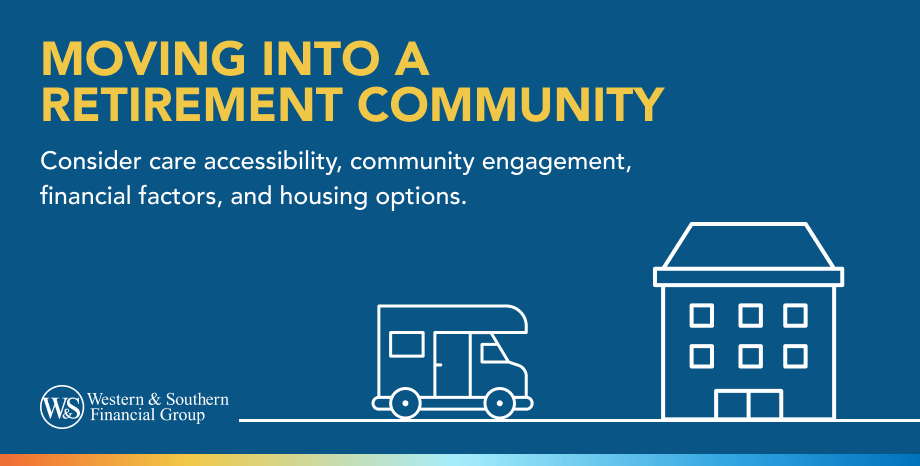

Table of Contents
Key Takeaways
- Retirement community choice involves care access, engagement, and financial planning.
- CCRCs offer comprehensive services, while niche and cohousing provide unique options.
- Consider personal needs, finances, and community preferences for a successful transition.
Is moving into a retirement community right for you? The answer depends upon many factors, but to fully consider the question, you should begin with a basic understanding of your options — including the option of staying put.
Should I Stay Home?
Making the decision to live in one's present home, or perhaps another one with fewer stairs to climb or maintenance needs, might come down to determining how easily you can access the extra personal and medical care you may need down the road. The availability of such care is often influenced by whether you have any children settled nearby. Also important is how engaged you are in your community with activities you can maintain well into your retirement years.
Continuing Care Retirement Community (CRRC)
Perhaps the most common retirement community model is the continuing care retirement community (CCRC).1 These establishments are owned and managed by both non- and for-profit organizations, and are designed to meet the full spectrum of retirees' personal, social and medical needs. Residents generally can only move to CCRCs when they're in reasonably good health.
CCRC costs vary considerably based on their:
- Housing options
- Amenities
- Available services
- Geographic location
Fee models also vary. CCRCs typically require payment of an initial entrance fee, in addition to monthly fees based on the level of service desired. The up-front fee might be partially refundable depending upon how long you live there, or fully refundable (to you or your heirs) if you pay higher monthly fees.
What Care Will I Receive in a CCRC?
If and when CCRC residents require greater support, they can move within the community to a location that provides assisted living care, often includes:
- Meal preparation
- Housekeeping
- Help with some of the "activities of daily living," such as bathing and dressing
- Overall health safety monitoring
If skilled nursing and rehab services are required, those are also available on-site at a CCRC.
The complexity of financial options and service packages in a CCRC might make it worthwhile to bring in an attorney or specialized advisor to help you fully understand your choices and the fine print that accompanies them. It's also essential to thoroughly review a CCRC's financial stability to help make sure it will survive as long as you live there.
What Are My Other Options?
There are also some more independent community options available.
Niche (or Affinity) Retirement Communities
One is niche (or affinity) retirement communities. These places cater to retirees with either similar personal backgrounds (such as national origin or religion) or interests (such as creative expression or lifelong learning). Niche communities might not be set up as CCRCs, meaning residents must sort out their own health care services. The financial structure of affinity housing is simple: Residents rent their homes, typically apartments, without entrance fees.
Cohousing
Another retirement community option is senior "cohousing." Cohousing is "community intentionally designed with ample common spaces surrounded by private homes," according to the Cohousing Association of the United States.2 It's a good option for those seeking to preserve their connection to a community, but who hope to find one that lives at a pace closer to their own.
Because cohousing communities feature shared space and, often, a building where residents can meet and eat together, community dues usually take the form of required fees, similar to those in a condominium or homeowners' association (HOA) community. However, residents own their own homes, and costs vary by community.
What Are the Financial Considerations?
As noted, your finances can play a role in helping you reach a decision on a retirement community. For example, suppose you own your home but don't need as large of a house and would like to spend less of your income on property taxes and upkeep. You might have downsizing on your mind. If you were to move to a retirement community with affordable fees, rent, security deposit requirements or home price tags, you may want to sell your current home sooner rather than later. That way, you can add the net sale proceeds to your retirement savings and consider moving into a retirement community when the time is right for you.
On the other hand, as also noted, some retirement living arrangements cost much more than others. Moving into an elegant CCRC, for example, could substantially raise your cost of living. It could be money well spent, but depending upon your circumstances, you might risk expending your savings sooner than you planned.
Monitoring your progress through a series of retirement age milestones can help give you maximum flexibility in deciding whether, where and when to make a move. The sooner you start thinking about your living arrangements in retirement, the sooner you can start saving and organizing your overall financial strategy to meet those goals.
Sources
- What to Know About Continuing Care Retirement Communities. https://health.usnews.com/senior-care/caregiving/articles/continuing-care-retirement-communities.
- Cohousing. https://www.cohousing.org/what-cohousing/cohousing/.















